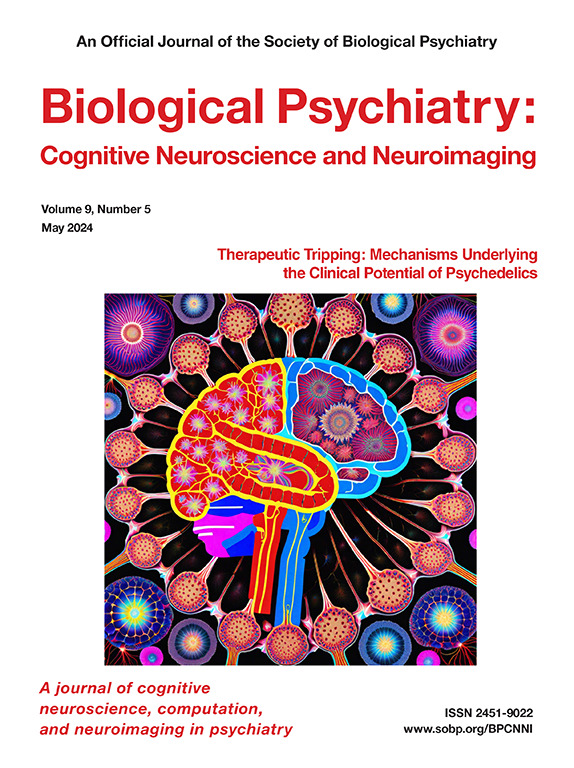表面之外:深度经颅磁刺激在减少成瘾障碍的渴望中的功效。系统回顾和荟萃分析。
IF 4.8
2区 医学
Q1 NEUROSCIENCES
Biological Psychiatry-Cognitive Neuroscience and Neuroimaging
Pub Date : 2025-10-01
DOI:10.1016/j.bpsc.2025.03.012
引用次数: 0
摘要
背景:物质使用障碍(SUDs)和赌博障碍(GD)是一种慢性成瘾疾病。由于常规治疗的疗效有限,人们对针对这些疾病背后改变的神经回路的替代方法越来越感兴趣。深经颅磁刺激(dTMS)已成为一种很有前途的神经调节技术,能够到达深部和双侧脑区。然而,目前尚无明确的建议将其用于成瘾治疗。本研究系统回顾并定量分析了dTMS在sud和GD中的作用。方法:根据PRISMA指南,筛选截至2024年2月的4个电子数据库,并选择相关的英文原创研究文章。17篇论文被纳入系统评价。由于只有少数研究采用假对照设计,我们对12项研究的子集进行了荟萃分析,计算真实刺激前后的标准化平均变化(SMCC)作为效应大小,使用自我报告的渴望分数作为因变量。结果:结果显示,真正的dTMS在降低渴望评分方面有显著而大的效果(SMCC = - 1.26, 95% CI [-1.67, - 0.86], p)。结论:结果为dTMS治疗SUDs的有效性提供了初步证据。目前的局限性和未来的方向进行了批判性的讨论,强调需要进一步严格的研究,以完善治疗潜力,并为dTMS临床应用制定基于共识的指导方针。本文章由计算机程序翻译,如有差异,请以英文原文为准。
Beyond the Surface: Deep Transcranial Magnetic Stimulation Efficacy in Reducing Craving in Addictive Disorders: A Systematic Review and Meta-Analysis
Background
Substance use disorders (SUDs) and gambling disorder (GD) are addictive diseases with a chronic course. Due to the limited efficacy of conventional treatments, there is growing interest in alternative approaches that target the altered neural circuits underlying these disorders. Deep transcranial magnetic stimulation (dTMS) has emerged as a promising neuromodulation technique capable of reaching deep and bilateral brain regions. However, no definite recommendation for its use in addiction treatment exists. In this study, we systematically reviewed and quantitatively analyzed dTMS effects in SUDs and GD.
Methods
Following the Preferred Reporting Items for Systematic Reviews and Meta-Analyses (PRISMA) guidelines, we screened 4 electronic databases up to February 2024 and selected relevant original English-language research articles. Seventeen articles were included in the systematic review and 12 in the meta-analysis. Because only a minority of studies used a sham-controlled design, we ran a main analysis computing the standardized mean change (SMCC) from pre to post real stimulation as the effect size, with self-reported craving scores as the outcome measure.
Results
The results showed a significant and large effect of real dTMS in reducing craving scores (SMCC = −1.26; 95% CI, −1.67 to −0.86; p < .001). High heterogeneity across studies was found at both quantitative and qualitative levels.
Conclusions
Results provide preliminary evidence supporting the effectiveness of dTMS for the treatment of SUDs. Current limitations and future directions are critically discussed, highlighting the need for further rigorous research to refine the therapeutic potential and develop consensus-based guidelines for dTMS clinical application.
求助全文
通过发布文献求助,成功后即可免费获取论文全文。
去求助
来源期刊

Biological Psychiatry-Cognitive Neuroscience and Neuroimaging
Neuroscience-Biological Psychiatry
CiteScore
10.40
自引率
1.70%
发文量
247
审稿时长
30 days
期刊介绍:
Biological Psychiatry: Cognitive Neuroscience and Neuroimaging is an official journal of the Society for Biological Psychiatry, whose purpose is to promote excellence in scientific research and education in fields that investigate the nature, causes, mechanisms, and treatments of disorders of thought, emotion, or behavior. In accord with this mission, this peer-reviewed, rapid-publication, international journal focuses on studies using the tools and constructs of cognitive neuroscience, including the full range of non-invasive neuroimaging and human extra- and intracranial physiological recording methodologies. It publishes both basic and clinical studies, including those that incorporate genetic data, pharmacological challenges, and computational modeling approaches. The journal publishes novel results of original research which represent an important new lead or significant impact on the field. Reviews and commentaries that focus on topics of current research and interest are also encouraged.
 求助内容:
求助内容: 应助结果提醒方式:
应助结果提醒方式:


